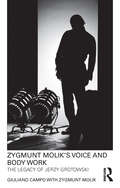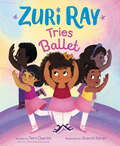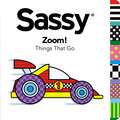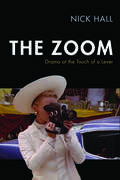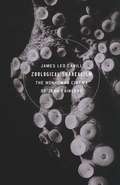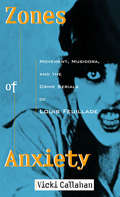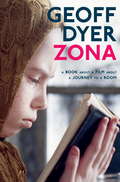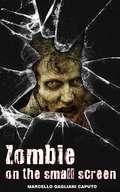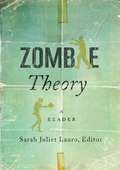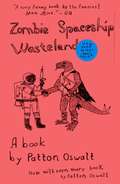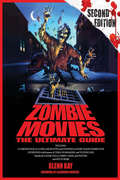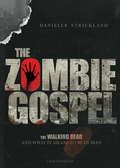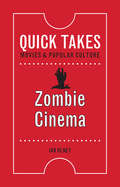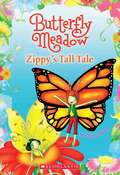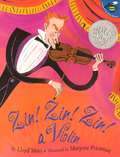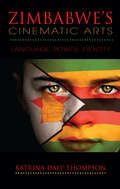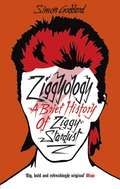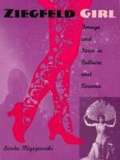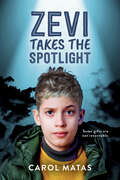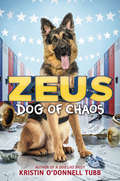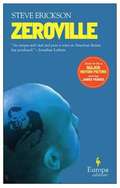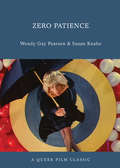- Table View
- List View
Zygmunt Molik's Voice and Body Work: The Legacy of Jerzy Grotowski
by Giuliano Campo Zygmunt MolikOne of the original members of Jerzy Grotowski’s acting company, Zygmunt Molik’s Voice and Body Work explores the unique development of voice and body exercises throughout his career in actor training. This book, constructed from conversations between Molik and author Giuliano Campo, provides a fascinating insight into the methodology of this practitioner and teacher, and focuses on his ‘Body Alphabet’ system for actors, allowing them to combine both voice and body in their preparatory process.
Zuri Ray Tries Ballet
by Tami CharlesFrom New York Times bestselling author Tami Charles and rising star illustrator Sharon Sordo comes the first book in a charming picture book series about a fun, spunky girl with a huge heart! Meet Zuri Ray. She’s always willing to go the extra mile for family and friends and is up for any challenge. At least, that was before her best friend, Jessie, asked her to join a ballet camp. Now Zuri isn’t sure if she’s up for everything. While Jessie can’t wait to chassé and plié while wearing tight hair buns and frilly tutus, that doesn’t sound like Zuri at all! But she can’t let her friend down. Maybe classical ballet just needs a new spin . . . Perfect for fans of Fancy Nancy and Fresh Princess, Zuri Ray Tries Ballet encourages kids to follow their hearts and stay true to themselves!
Zukunftswissen?: Potenziale prospektiver Erkenntnis am Beispiel der Energiewirtschaft (Abhandlungen zur Medien- und Kulturwissenschaft)
by Manuel MackasareVorstellungen von der Zukunft bestimmen das menschliche Handeln. In energiewirtschaftlichen Fragen sind solche Antizipationen besonders relevant: Staaten beschließen Förderprogramme, Unternehmen errichten Kraftwerke, Privatpersonen füllen ihre Öltanks oder ersetzen sie durch Wärmepumpen – stets mit Blick auf ein Morgen, der mitunter trügerisch ist. Kontrovers diskutiert wird, ob es ein Wissen von der Zukunft überhaupt geben und inwieweit es Gegenstand der Wissenschaft sein kann. Die Beiträge dieses Bandes untersuchen Möglichkeit, Methoden und Geltung von Zukunftsentwürfen aus philosophischer, historischer, sozial-, literatur- und medienwissenschaftlicher Perspektive.
Zoom!: Things That Go (Sassy)
by Grosset & DunlapMom, dad, and baby will love our line of books from Sassy, the award-winning and innovative toy company. This book teaches babies all about things that go zoom! Cars, trucks, boats, and airplanes are just some of the vehicles babies will learn about in this book.
The Zoom: Drama at the Touch of a Lever (Techniques of the Moving Image)
by Nick HallFrom the queasy zooms in Alfred Hitchcock’s Vertigo to the avant-garde mystery of Michael Snow’s Wavelength, from the excitement of televised baseball to the drama of the political convention, the zoom shot is instantly recognizable and highly controversial. In The Zoom, Nick Hall traces the century-spanning history of the zoom lens in American film and television. From late 1920s silent features to the psychedelic experiments of the 1960s and beyond, the book describes how inventors battled to provide film and television studios with practical zoom lenses, and how cinematographers clashed over the right ways to use the new zooms. Hall demonstrates how the zoom brought life and energy to cinema decades before the zoom boom of the 1970s and reveals how the zoom continues to play a vital and often overlooked role in the production of contemporary film and television.
Zoological Surrealism: The Nonhuman Cinema of Jean Painlevé
by James Leo CahillAn archive-based, in-depth analysis of the surreal nature and science movies of the pioneering French filmmaker Jean PainlevéBefore Jacques-Yves Cousteau, there was Jean Painlevé, a pioneering French scientific and nature filmmaker with a Surrealist’s eye. Creator of more than two hundred films, his studies of strange animal worlds doubled as critical reimaginations of humanity. With an unerring eye for the uncanny and unexpected, Painlevé and his assistant Geneviève Hamon captured oneiric octopuses, metamorphic crustaceans, erotic seahorses, mythic vampire bats, and insatiable predatory insects. Zoological Surrealism draws from Painlevé’s early oeuvre to rethink the entangled histories of cinema, Surrealism, and scientific research in interwar France. Delving deeply into Painlevé’s archive, James Leo Cahill develops an account of “cinema’s Copernican vocation”—how it was used to forge new scientific discoveries while also displacing and critiquing anthropocentric viewpoints. From Painlevé’s engagements with Sergei Eisenstein, Georges Franju, and competing Surrealists to the historiographical dimensions of Jean Vigo’s concept of social cinema, Zoological Surrealism taps never-before-examined sources to offer a completely original perspective on a cutting-edge filmmaker. The first extensive English-language study of Painlevé’s early films and their contexts, it adds important new insight to our understanding of film while also contributing to contemporary investigations of the increasingly surreal landscapes of climate change and ecological emergency.
Zones of Anxiety: Movement, Musidora, and the Crime Serials of Louis Feuillade
by Vicki CallahanA feminist analysis of the "cinema of uncertainty" through an examination of the crime serials of Louis Feuillade and the work of actress Musidora.
Zona: A Book About a Film About a Journey to a Room
by Geoff DyerFrom a writer whose mastery encompasses fiction, criticism, and the fertile realm between the two, comes a new book that confirms his reputation for the unexpected.In Zona, Geoff Dyer attempts to unlock the mysteries of a film that has haunted him ever since he first saw it thirty years ago: Andrei Tarkovsky's Stalker, widely regarded as one of the greatest films of all time. ("Every single frame," declared Cate Blanchett, "is burned into my retina.") As Dyer guides us into the zone of Tarkovsky's imagination, we realize that the film is only the entry point for a radically original investigation of the enduring questions of life, faith, and how to live. In a narrative that gives free rein to the brilliance of Dyer's distinctive voice--acute observation, melancholy, comedy, lyricism, and occasional ill-temper--Zona takes us on a wonderfully unpredictable journey in which we try to fathom, and realize, our deepest wishes.Zona is one of the most unusual books ever written about film, and about how art--whether a film by a Russian director or a book by one of our most gifted contemporary writers--can shape the way we see the world and how we make our way through it.
Zombies on the small screen
by Marcello Gagliani Caputo Andrew Bell, MITI, ATA, Dip. PublishingHaving saturated the world of cinema, the zombie has found new, fertile ground on television, where the character has rediscovered its youth. From the success of "The Walking Dead" to the spin-off "Fear the Walking Dead", from the surprise hit "Dead Set" to the poignant "In the Flesh"; from The Asylum's "Z-Nation'" to the romantic delicacy of the French production, "Les Revenants"; this volume includes the best zombie TV series hitting TV screens worldwide, with critical analysis fascinating insights into the genre.
Zombie Theory: A Reader
by Sarah Juliet LauroZombies first shuffled across movie screens in 1932 in the low-budget Hollywood film White Zombie and were reimagined as undead flesh-eaters in George A. Romero’s The Night of the Living Dead almost four decades later. Today, zombies are omnipresent in global popular culture, from video games and top-rated cable shows in the United States to comic books and other visual art forms to low-budget films from Cuba and the Philippines. The zombie’s ability to embody a variety of cultural anxieties—ecological disaster, social and economic collapse, political extremism—has ensured its continued relevance and legibility, and has precipitated an unprecedented deluge of international scholarship. Zombie studies manifested across academic disciplines in the humanities but also beyond, spreading into sociology, economics, computer science, mathematics, and even epidemiology. Zombie Theory collects the best interdisciplinary zombie scholarship from around the world. Essays portray the zombie not as a singular cultural figure or myth but show how the undead represent larger issues: the belief in an afterlife, fears of contagion and technology, the effect of capitalism and commodification, racial exclusion and oppression, dehumanization. As presented here, zombies are not simple metaphors; rather, they emerge as a critical mode for theoretical work. With its diverse disciplinary and methodological approaches, Zombie Theory thinks through what the walking undead reveal about our relationships to the world and to each other.Contributors: Fred Botting, Kingston U; Samuel Byrnand, U of Canberra; Gerry Canavan, Marquette U; Jeffrey Jerome Cohen, George Washington U; Jean Comaroff, Harvard U; John Comaroff, Harvard U; Edward P. Comentale, Indiana U; Anna Mae Duane, U of Connecticut; Karen Embry, Portland Community College; Barry Keith Grant, Brock U; Edward Green, Roosevelt U; Lars Bang Larsen; Travis Linnemann, Eastern Kentucky U; Elizabeth McAlister, Wesleyan U; Shaka McGlotten, Purchase College-SUNY; David McNally, York U; Tayla Nyong’o, Yale U; Simon Orpana, U of Alberta; Steven Shaviro, Wayne State U; Ola Sigurdson, U of Gothenburg; Jon Stratton, U of South Australia; Eugene Thacker, The New School; Sherryl Vint, U of California Riverside; Priscilla Wald, Duke U; Tyler Wall, Eastern Kentucky U; Jen Webb, U of Canberra; Jeffrey Andrew Weinstock, Central Michigan U.
Zombie Spaceship Wasteland: A Book by Patton Oswalt
by Patton OswaltPrepare yourself for a journey through the world of Patton Oswalt, one of the most creative, insightful, and hysterical voices on the entertainment scene today. Widely known for his roles in the films Big Fan and Ratatouille, as well as the television hit The King of Queens, Patton Oswalt--a staple of Comedy Central--has been amusing audiences for decades. Now, with Zombie Spaceship Wasteland, he offers a fascinating look into his most unusual, and lovable, mindscape. Oswalt combines memoir with uproarious humor, from snow forts to Dungeons & Dragons to gifts from Grandma that had to be explained. He remembers his teen summers spent working in a movie Cineplex and his early years doing stand-up. Readers are also treated to several graphic elements, including a vampire tale for the rest of us and some greeting cards with a special touch. Then there's the book's centerpiece, which posits that before all young creative minds have anything to write about, they will home in on one of three story lines: zombies, spaceships, or wastelands. Oswalt chose wastelands, and ever since he has been mining our society's wasteland for perversion and excess, pop culture and fatty foods, indie rock and single-malt scotch. Zombie Spaceship Wasteland is an inventive account of the evolution of Patton Oswalt's wildly insightful worldview, sure to indulge his legion of fans and lure many new admirers to his very entertaining "wasteland."
Zombie Spaceship Wasteland: A Book by Patton Oswalt
by Patton OswaltPrepare yourself for a journey through the world of Patton Oswalt, one of the most creative, insightful, and hysterical voices on the entertainment scene today. Widely known for his roles in the films Big Fan and Ratatouille, as well as the television hit The King of Queens, Patton Oswalt--a staple of Comedy Central--has been amusing audiences for decades. Now, with Zombie Spaceship Wasteland, he offers a fascinating look into his most unusual, and lovable, mindscape. Oswalt combines memoir with uproarious humor, from snow forts to Dungeons & Dragons to gifts from Grandma that had to be explained. He remembers his teen summers spent working in a movie Cineplex and his early years doing stand-up. Readers are also treated to several graphic elements, including a vampire tale for the rest of us and some greeting cards with a special touch. Then there's the book's centerpiece, which posits that before all young creative minds have anything to write about, they will home in on one of three story lines: zombies, spaceships, or wastelands. Oswalt chose wastelands, and ever since he has been mining our society's wasteland for perversion and excess, pop culture and fatty foods, indie rock and single-malt scotch. Zombie Spaceship Wasteland is an inventive account of the evolution of Patton Oswalt's wildly insightful worldview, sure to indulge his legion of fans and lure many new admirers to his very entertaining "wasteland."
Zombie Spaceship Wasteland
by Patton OswaltPrepare yourself for a journey through the world of Patton Oswalt, one of the most creative, insightful, and hysterical voices on the entertainment scene today. Widely known for his roles in the films Big Fan and Ratatouille, as well as the television hit The King of Queens, Patton Oswalt--a staple of Comedy Central--has been amusing audiences for decades. Now, with Zombie Spaceship Wasteland, he offers a fascinating look into his most unusual, and lovable, mindscape. Oswalt combines memoir with uproarious humor, from snow forts to Dungeons & Dragons to gifts from Grandma that had to be explained. He remembers his teen summers spent working in a movie Cineplex and his early years doing stand-up. Readers are also treated to several graphic elements, including a vampire tale for the rest of us and some greeting cards with a special touch. Then there's the book's centerpiece, which posits that before all young creative minds have anything to write about, they will home in on one of three story lines: zombies, spaceships, or wastelands. Oswalt chose wastelands, and ever since he has been mining our society's wasteland for perversion and excess, pop culture and fatty foods, indie rock and single-malt scotch. Zombie Spaceship Wasteland is an inventive account of the evolution of Patton Oswalt's wildly insightful worldview, sure to indulge his legion of fans and lure many new admirers to his very entertaining "wasteland."
Zombie Movies: The Ultimate Guide
by Glenn Kay Alejandro BruguésFeaturing chronological reviews of more than 300 zombie films--from 1932's White Zombie to the AMC series The Walking Dead--this thorough, uproarious guide traces the evolution of one of horror cinema's most popular and terrifying creations. Fans will learn exactly what makes a zombie a zombie, go behind the scenes with a chilling production diary from Land of the Dead, peruse a bizarre list of the oddest things ever seen in undead cinema, and immerse themselves in a detailed rundown of the 25 greatest zombie films ever made. Containing an illustrated zombie rating system, ranging from "Highly Recommended" to "Avoid at All Costs" and "So Bad It's Good," the book also features lengthy interviews with numerous talents from in front of and behind the camera. This updated and expanded second edition contains more than 100 new and rediscovered films, providing plenty of informative and entertaining brain food for movie fans.
The Zombie Gospel: The Walking Dead and What It Means to Be Human
by Danielle StricklandThe Walking DeadThe Zombie GospelThe Walking DeadThe Walking Dead
Zombie Cinema
by Ian OlneyIt’s official: the zombie apocalypse is here. The living dead have been lurking in popular culture since the 1930s, but they have never been as ubiquitous or as widely-embraced as they are today.Zombie Cinema is a lively and accessible introduction to this massively popular genre. Presenting a historical overview of zombie appearances in cinema and on television, Ian Olney also considers why, more than any other horror movie monster, zombies have captured the imagination of twenty-first-century audiences. Surveying the landmarks of zombie film and TV, from White Zombie to The Walking Dead, the book also offers unique insight into why zombies have gone global, spreading well beyond the borders of American and European cinema to turn up in films from countries as far-flung as Cuba, India, Japan, New Zealand, and Nigeria. Both fun and thought-provoking, Zombie Cinema will give readers a new perspective on our ravenous hunger for the living dead.
Zippy's Tall Tale (Butterfly Meadow #8)
by Olivia MossDazzle decides to join the spunky new butterfly Zippy on a quick trip, and they have a great time meeting animals she's never seen before. But when they return to Butterfly Meadow, Zippy tells some tall tales about their adventures.
Zin! Zin! Zin! A Violin
by Lloyd MossUsing evocative poetic language, the author describes ten instruments coming on stage and performing, to the delight of the audience. [This text is listed as an example that meets Common Core Standards in English language arts for K-1 at http://www.corestandards.org.]
Zimbabwe's Cinematic Arts: Language, Power, Identity
by Katrina Daly Thompson“A nuanced and convincing approach to evaluating the role of media in shaping African identities.” —James Burns, Clemson UniversityThis timely book reflects on discourses of identity that pervade local talk and texts in Zimbabwe, a nation beset by political and economic crisis. Exploring questions of culture that play out in broadly accessible local and foreign film and television, Katrina Daly Thompson shows how viewers interpret these media and how they impact everyday life, language use, and thinking about community. Thompson offers a unique understanding of how media reflect and contribute to Zimbabwean culture, language, and ethnicity.“Katrina Daly Thompson has made a fine contribution to scholarship on African cinema . . . This is a book that will enrich discussions of African film and media studies for years to come.” —African Studies Review“Thompson analyzes identity discourses through cinematic arts?films, documentaries, television programs, videos?consumed (whether or not produced) in Zimbabwe . . . . Beside bringing issues of race, financing, ethnicity, and language to the discussion, she also considers the 2001 Broadcasting Services Act, which was meant to liberalize the field and stem Western influence . . . Recommended.” —Choice“Katrina Daly Thompson’s study of Zimbabwean film and television presents a valuable addition to the ever-expanding corpus of analytical and historical studies on African film and media.” —Africa“Most compelling in Thompson’s study is her close attention to uses of language and culture, which she argues contest state-defined and state-controlled meaning in broadcast media. Recognizing culture as a socially negotiated process, the book uses critical discourse analysis to interrogate power structures and flows.” ?African Arts
Ziggyology
by Simon GoddardHe came from Outer Space...It was the greatest invention in the history of pop music – the rock god who came from the stars – which struck a young David Bowie like a lightning bolt from the heavens. When Ziggy the glam alien messiah fell to Earth, he transformed Bowie from a prodigy to a superstar who changed the face of music forever. But who was Ziggy Stardust? And where did he really come from?In a work of supreme pop archaeology, Simon Goddard unearths every influence that brought Ziggy to life – from HG Wells to Holst, Kabuki to Kubrick, and Elvis to Iggy. Ziggyology documents the epic drama of the Starman’s short but eventful time on Planet Earth… and why Bowie eventually had to kill him.
Ziegfeld Girl: Image and Icon in Culture and Cinema
by Linda MizejewskiIn the first decades of the twentieth century, Broadway teemed with showgirls, but only the Ziegfeld Girl has survived in American popular culture--as a figure of legend, nostalgia, and camp. Featured in Florenz Ziegfeld Jr.'s renowned revues, which ran on Broadway from 1907 to 1931, the Ziegfeld Girl has appeared in her trademark feather headdresses, parading and posing, occasionally singing and dancing, in numerous musicals and musical films paying direct or indirect homage to the intrepid producer and his glorious Girl. Linda Mizejewski analyzes the Ziegfeld Girl as a cultural icon and argues that during a time when American national identity was in flux, Ziegfeld Girls were both products and representations of a white, upscale, heterosexual national ideal. Mizejewski traces the Ziegfeld Girl's connections to turn-of-the-century celebrity culture, black Broadway, the fashion industry, and the changing sexual and gender identities evident in mainstream entertainment during the Ziegfeld years. In addition, she emphasizes how crises of immigration and integration made the identity and whiteness of the American Girl an urgent issue on Broadway's revue stages during that era. Although her focus is on the showgirl as a "type," the analysis is intermingled with discussions of figures like Anna Held, Fanny Brice, and Bessie McCoy, the Yama Yama girl, as well as Ziegfeld himself. Finally, Mizejewski discusses the classic American films that have most vividly kept this showgirl alive in both popular and camp culture, including The Great Ziegfeld, Ziegfeld Girl, and the Busby Berkeley musicals that cloned Ziegfeld's showgirls for decades. Ziegfeld Girl will appeal to scholars and students in American studies, popular culture, theater and performance studies, film history, gender studies, gay and lesbian studies, and social history.
Zevi Takes the Spotlight (Orca Currents)
by Carol MatasKey Selling Points Thirteen-year-old Zevi uses his psychic powers to save the life of a famous actor during the filming of a movie. This story examines the effects of fame and the importance of choices, while exploring themes of responsibility, empathy and doing the right thing. Carol Matas is an internationally acclaimed and award-winning author of dozens of books for young people. She’s written in a variety of genres, including historical fiction, sci-fi, supernatural and thriller. She is also a graduate of the Actor’s Lab in London, England, and pursued an acting career for a few years. The accuracy of the movie set and filming scenes was expert reviewed by filmmaker John Kozak, a professor of film at the University of Winnipeg. Enhanced features (dyslexia-friendly font, cream paper, larger trim size) to increase reading accessibility for dyslexic and other striving readers.
Zeus, Dog of Chaos
by Kristin O'Donnell TubbKristin O’Donnell Tubb, the award-winning author of A Dog Like Daisy, delivers another heartwarming must-read middle grade novel for dog lovers. Equal parts funny and poignant, this book from the point of view of the service dog, Zeus, is perfect for fans of Max and A Dog Called Homeless. <P><P>Zeus comes from a long line of heroic dogs, and he dreams of glory as a K9 commander. But he receives a much more dangerous assignment—middle school! And as all good service dogs know, the only way to get through hostile territory is by being invisible. <P><P>Zeus’s new human, Madden, is diabetic, and he wants to be invisible, too. That’s hard to do with a huge German Shepherd at his side to alert him when his blood sugar drops. And it’s even harder because Madden makes this noise called music that draws attention. Zeus’s mission becomes clear: he must destroy music. <P><P>While Zeus’s training prepared him for his most important job—keeping Madden safe—he discovers the human world is complicated. As Madden dreams of winning the state band competition and tries to reconnect with his mom, the lieutenant, Zeus must learn that, sometimes, you need to stand out to fulfill your duty.
Zeroville
by Steve EricksonIt is an August afternoon in 1969. A hippie "family" led by Charles Manson commits five savage murders in the canyons above L.A. The same day, a young, ex-communicated theology student walks Hollywood Boulevard, having just arrived in town with the images of Elizabeth Taylor and Montgomery Clift tattooed on his shaved head. At once childlike and violent, Vikar is not a cineaste but "cineautistic," sleeping in the Roosevelt Hotel where he is haunted by the ghost of D. W. Griffith. He has stepped into the vortex of a "culture in upheaval: drugs that frighten him, a sexuality that consumes him, a music he doesn't understand. He's come to Hollywood to pursue his obsession with film, only to find a Hollywood that's as indifferent to film as it is to Vikar.
Zero Patience: A Queer Film Classic
by Susan Knabe Wendy Gay PearsonA Queer Film Classic on John Greyson's controversial 1993 film musical about the AIDS crisis which combines experimental, camp musical, and documentary aesthetics while refuting the legend of Patient Zero, the male flight attendant accused in Randy Shilts' book And the Band Played On of bringing the AIDS crisis to North America. Wendy Gay Pearson and Susan Knabe both teach in the women's studies and Feminist Research department at the University of Western Ontario. Arsenal's Queer Film Classics series cover some of the most important and influential films about and by LGBTQ people.
